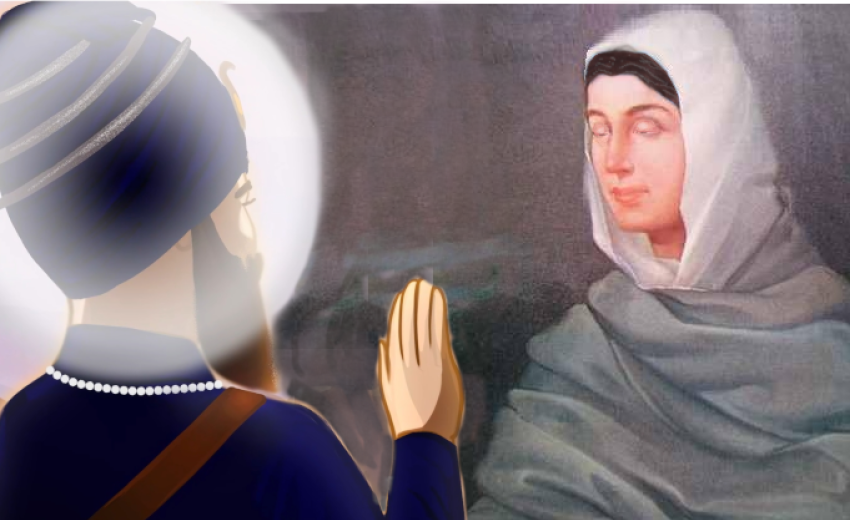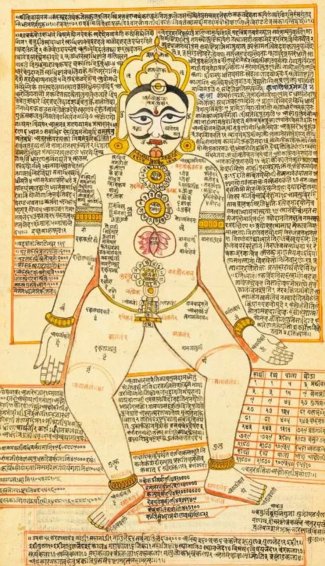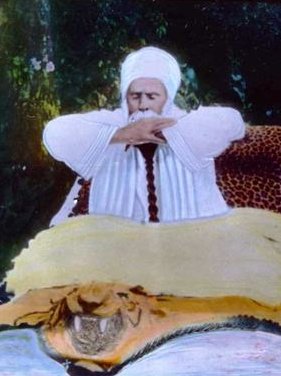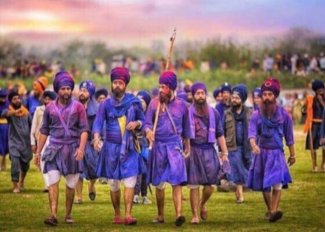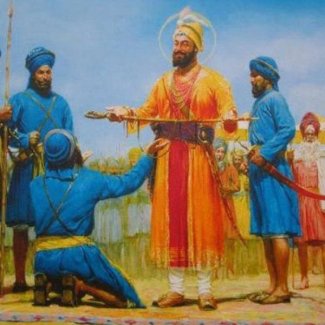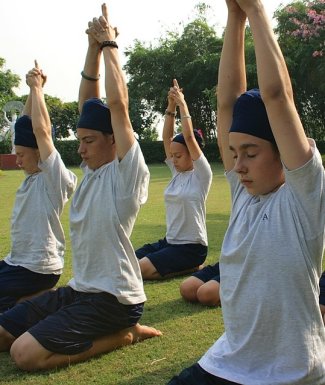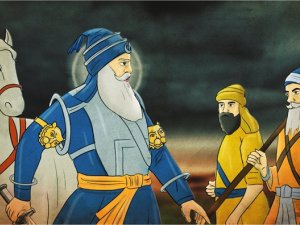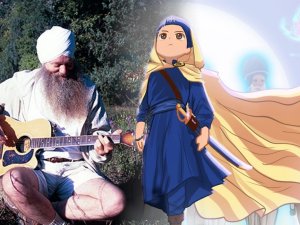Mata Jito Ji was the first wife of the 10th Guru. Besides being the mother of the heroic Sahibzaade we typically do not know much more about her. Are there any big incidences or saakhis that she was central to? There is the story of her marriage which lead to the creation of Guru Ki Lahore. Beyond that we typically haven't heard much. Yet there is a very profound story of Mata Jito Ji that is somehow not known though it is available to be seen like any other saakhi. It is told in several history texts (Sau Sakhi, Guru Pad Prem Prakash and possibly others) and below it will be relayed through the Suraj Prakash Granth.
This is the story of her leaving her body after gaining the ability to see the future.
We'll first give a line-by-line translation of the teaching session she had with Guru Gobind Singh that led to her spiritual achievements, followed by a summary of the next chapter and then observations and conclusion.
Translation
This episode is found in the chapter called 'Shraad Nirnai' (Page 595)
The first half of the chapter is unrelated to the Mata Jito Ji section which starts on paurhi 31.
31.1 ਕਹਿ ਕਰਿ ਮੰਦਰ ਮੋਂ ਗਏ, ਥਿਰੇ ਸੇਜ ਪਰ ਜਾਇ॥ Saying this he (Guru Gobind Singh) retired to his room and laid on his bed.
31.2 ਤਬਿ ਗੁਰ ਮਹਿਲਾ ਦੀਰਘਾ, ਜੀਤੋ ਜਿਸ ਕਾ ਨਾਇ॥ Then came in the eldest wife, Jito was her name.
32.1 ਪਹੁਂਚੀ ਸ਼੍ਰੀ ਕਲਗ਼ੀਧਰ ਪਾਸ॥ She came up to Sri Kalgidhar.
32.2 ਜਿਸ ਕੇ ਰਿਦੇ ਸ਼੍ਰੇਯ ਕੀ ਆਸ॥ With a prayer in her heart for completion (spiritual fulfillment).
32.3 ਬਾਰ ਬਾਰ ਪਦ ਬੰਦਨ ਕਰੀ॥ Again and again she bowed to his feet.
32.4 ਭਨਤਿ ਬਿਨੈ ਕਰ ਜੋਰਿ ਹੁਇ ਖਰੀ॥ She stood with her hands clasped together for her prayer.
33.1 ਕਮਲ ਬਿਲੋਚਨ ਤੇ ਗੁਰ ਹੇਰੀ॥ Gazing at her with his lotus eyes.
33.2 ਹੁਇ ਪ੍ਰਸੰਨ ਬੋਲੇ ਤਿਸ ਬੇਰੀ॥ He was pleased, and asked.
33.3 ਘਰ ਵਾਲ੍ਯੋ ਮਨ ਮਤਾ ਤੁਹਾਰਾ॥ "Hey wife! What is on your mind?"
33.4 ਕਿਸ ਬਿਧ ਕੋ ਹੈ? ਕਰੋ ਉਚਾਰਾ॥ "What is it? Speak it."
34.1 ਕਹਿਬੇ ਉਚਤਿ ਹੋਇ ਕਛੁ ਕਹੋ॥ "Say the appropriate thing..."
34.2 ਜਥਾ ਕਾਮਨਾ ਤੈਸੇ ਲਹੋ’॥ "...which brings out (expresses) your desire."
34.3 ਸੁਨਿ ਅਧੀਨ ਹੁਇ ਜੀਤੋ ਤਬੈ॥ After Jito subserviently heard this...
34.4 ਮਨ ਕੋ ਮਤਾ ਭਨਤਿ ਭੀ ਸਬੈ॥ ... she (began) expressing all the prayers of her mind,
35.1 ਜਗ ਗੁਰ! ਮੈਂ ਹੌਂ ਤੁਮਰੇ ਗ੍ਰੇਹ॥ "Guru of the world! I am your house wife."
35.2 ਹਮ ਭੀ ਅਹੈਂ ਮਾਨੁਖੀ ਦੇਹ॥ "But I also have a human body."
35.3 ਕਹਾਂ ਭਯੋ ਜੇ ਤ੍ਰੀਮਤ ਜਾਮਾ॥ "What happened that I have the birth of a woman?!"
35.4 ਬੀਤੀ ਬੈਸ ਆਪ ਕੇ ਧਾਮਾ॥ "I spend my life (looking after) your estate."
36.1 ਪ੍ਰਾਪਤਿ ਨਹਿਂ ਸਤਿਸੰਗ ਵਿਸ਼ੇਸ਼ਹੁ॥ "I don't get the benefit of the special sat sangat"
36.2 ਤੁਮ ਹੀ ਗੁਰ ਸਭਿ ਕੋ ਉਪਦੇਸ਼ਹੁ॥ "You are the Guru and you give teachings to everyone"
36.3 ਨਿਜ ਪ੍ਰਿਯ ਸਿੱਖਨਿ ਜਿਮ ਸਮੁਝਾਵਹੁ॥ "Just as you cause your very own beloved Sikhs to understand..."
36.4 ਤਿਮ ਮੋ ਕਉ ਉਪਦੇਸ਼ ਦ੍ਰਿੜਾਵਹੁ॥ "...in that way instill those teachings into me!"
37.1 ਨਿਤ ਹੀ ਚਿਤ ਕੀ ਚਾਹ ਬਖਾਨੀ॥ "I have expressed this wish that I constantly hold,"
37.2 ਮਨ ਥਿਰਤਾ ਲਹਿ ਜਿਮ ਨਿਜ ਥਾਨੀ॥ "that my mind is stable like my own station (not wandering)."
37.3 ਸ਼੍ਰੀ ਸਤਿਗੁਰ ਸੁਨ ਪਤਨੀ ਬਾਤ॥ Sri SatGuru heard the speech of his wife...
37.4 ਬੋਲੇ ਜੋਗ ਰੀਤੀ ਬੱਖ੍ਯਾਤ॥ ...and explained to her about the tradition of jog (yoga/union):
38.1 ‘ਮਨ ਤੇ ਸਭਿ ਸਾਧਨ ਬਨੇ, ਮਨ ਲਗ ਸਭਿ ਉਪਦੇਸ਼॥ "From the mind all the sadhanas (methods) are made, from the mind come all teachings."
38.2 ਮਨੂਆ ਪਲਟੈ ਗ੍ਯਾਨ ਹੁਇ, ਮਨ ਲਾਗੇ ਰਤਿ ਸ਼ੇਸ਼॥ "When the mind is switched (reformed), wisdom occurs. The mind falls in love with Shesh (God)."
39.1 ਮੁਖ ਰੂਧੈ ਲਖਿ ਸ੍ਵਾਸ ਕੋ, ਬ੍ਰਿਤ ਅੰਤਰ ਮੁਖਿ ਦੇਇ॥ "Close the mouth, watch the breathing, make the britt (focus) totally internal."
39.2 ਇਹੈ ਰੀਤਿ ਕਰਨਾ ਦੁਰਤਿ, ਮਨੂਆ ਮ੍ਰਿਗ ਸੁਖ ਲੇਇ॥ "By doing this tradition harshly (very seriously) the mind, like a deer (quickly), becomes peaceful."
40.1 ਨੈਨ ਲਗੇ ਬੈਨਨਿ ਲਗੇ ਸ਼੍ਰਵਨ, ਸ਼ਬਦ ਕੇ ਮੱਧ॥ "The eyes, speech and ears are fixed, fixed within the shabd."
40.2 ਉਪ੍ਰੰਤ ਮਨੂਆ ਬਿਖੈ ਤੇ, ਬ੍ਰਹਮਨੰਦ ਸੁਖ ਸੁੱਧ॥ "After this the mind beholds a godly bliss and perfect peace."
41.1 ਜਿਹਬਾ ਤਾਲੂ ਮੱਧ ਦੇ, ਨੈਨ ਲਗਾਵੈ ਨਾਕ॥ "The tongue is pressed to the middle the upper palate, the eyes are fixed on the nose."
41.2 ਪਹਿਲਾਂ ਐਸੇ ਸੇਵੀਐ, ਸਤਿਗੁਰ ਪਦ ਮਨ ਭਾਕ॥ "Once you've given yourself to this (above technique), engage the mind to the Satguru's feet."
42.1 ਨਾਭਿ ਠਹਿਰਾਵੈ ਸ੍ਵਾਸ ਜਬ, ਬਿੱ੍ਰਤਿ ਥੰਭਾਵੈ ਅੰਤਿ॥ "When the breath is held at the naabhi (naval), hold the focus there until the end (as long as you can hold your breath)."
42.1 ਬਹੀ ਬਾਸਨਾ ਰੋਕੀਏ, ਤੀਨ ਮਾਸ ਲਗੁ ਸੰਤ॥ "Stop the many desires, for 3 months attach yourself to the saints."
43.1 ਚੌਥ ਮਾਸ ਥਿਤ ਪਾਇ ਕੈ, ਨਾਮ ਵਸਤੁ ਜੋ ਦੇਖਿ॥ "In the fourth month, after pacifying (the mind), and beholding the merchandise of Naam..."
43.2 ਸੋਈ ਅੰਗ ਆਪਨ ਲਖੈ, ਇਹੀ ਜੁਗੀਸ਼ਰ ਪੇਖਿ॥ "...Then one perceives The Self in every fiber, and (metaphorically) wears the robes of a king yogi."
44.1 ਤੀਬਰ ਬਾਸ਼ਨਾ ਦੂਰ ਕਰਿ, ਜਿਉਂ ਜਲ ਮਕਰੀ ਧਾਇ॥ "Distance from sharp desires, like how the water spider escapes quickly."
44.2 ਐਸੀ ਸਾਧੋ ਸਾਧਨਾ, ਮਨੂਆ ਚਿੱਤ ਬਿਲਾਇ॥ "In this way purify the spiritual practice, and the (over)thinking of the mind will be shattered."
45.1 ਪੰਚ ਭੂਤ, ਭੂੰ, ਬਾਰਿ, ਹਰਿ, ਬਾਯੂ, ਗਗਨ, ਸਥੂਲ॥ "The five elements of earth, water, fire, air and sky (ether) are dense."
45.2 ਗੰਧ, ਰਸ, ਰੂਪ, ਸਪਰਸ, ਧੁਨਿ, ਸੂਖਮ ਕ੍ਰਮ ਇਹ ਮੂਲ॥ "Smell, taste, sight, touch and reverberation are the subtle roots (of the above 5)."
46.1 ਪ੍ਰਾਨ, ਅਪਾਨ, ਸਮਾਨ, ਤ੍ਰੈ, ਪੁਨ ਬਿਆਨ, ਉੱਦ੍ਯਾਨ॥ "Prana, apana, samana are three (of the 5 vayus in classic yogic teachings, the other two are) byaan and udyan (each vayu governs a different areas of the body and are associated with different essences of inspiration, elimination, assimilation, ascension and circulation)
46.2 ਉਰ, ਪਾਯੂ, ਰਿਦ, ਸੰਧ, ਲਖਿ ਨਾੜੀ ਪੰਚ ਸਥਾਨ॥ "(By doing this practice) these five stations are beheld: Heart, anus, naval, throat and the narhis (meridian pathways throughout the whole body)."
47.1 ਨਾਗ, ਕੱਛੂਓ, ਕਿੱ੍ਰਕਲੀ, ਦੇਵ ਦੱਤ, ਧਨ ਜੀਤ॥ "(these are the 5 up-prans which the second set of air energies among the 10 prans. The functions of these 5 are described in the next sentence, they are associated with actions rather than organs.)
47.2 ਉਦਗਾਰ, ਨੇਤ੍ਰ, ਛਿਕ, ਜੰਭਣਾ, ਮੂਏ ਕਪਾਲੀ ਰੀਤ॥ "Burp (naag), blinking (kachhuo/kooram), sneeze (krikali), yawning (dev datt), the tradition of piercing the skull of a corpse (in order to let the prana out of the body. This is related to dhan jeet/dhananjai i.e. the bloating of the corpse)."
48.1 ਭਿੰਨ ਭਿੰਨ ਸਭ ਬਾਂਟ ਕਰਿ ਤੱਤ੍ਵਨਿ ਧਾਤੂ ਬਾਂਟ॥ "In many different ways elements are divided in various divisions according their properties."
48.2 ਅੰਤਹਕਰਨ ਸੁ ਭਿੰਨ ਕਰਿ ਸ਼ੇਖ ਆਤਮਾ ਸਾਟ॥ "Separate the self from the antahkaran (the 4 part mechanism of consciousness: mann, chit, budhi and ahankar), to filter out the pure soul." (a deeper explanation of the 6 chakras and 10 pranas [or 'pavans'] within the body is given by Guru Nanak to the Yogis at Sumer in Adhiai 60, paurhis 49-53 hearing the story of which Guru Angad went into samadhi for 8 days.)
49.1 ਇਹੀ ਗ੍ਯਾਨ ਇਹ ਜੋਗ ਹੈ ਇਹੀ ਭਗਤਿ ਕਾ ਕਾਜ॥ "This is the work of wisdom, of yoga and of devotion."
49.2 ਜੱਗ ਦਾਨ ਤੀਰਥ ਤਪਨਿ ਜਾਂ ਬਿਧ ਮਨ ਕੋ ਸਾਜ॥ "Thusly the mind becomes (externally) decorated by religious practice, charity, pilgrimage and austere meditation (as it has already been internally purified by applying the above teachings)."
50.1 ਦਿਨ ਕੈ ਨਿਸ ਮਹਿਂ ਅਲਪ ਅਹਾਰੀ॥ "Both day and night have restricted sustenance (eat little)!"
50.2 ਦਮ ਕੋ ਸਾਧੈ ਮਨਹਿਂ ਸੁਧਾਰੀ॥ "Control the breath and purify the mind!"
50.3 ਮਿੱਥਿਆ ਤਨ ਧਨ ਸੁਤ ਅਰੁ ਦਾਰਾ॥ "(Understand that your) body, wealth, children and wife are illusory."
50.4 ਮਿੱਥਿਆ ਜਗੁ ਕੋ ਬ੍ਰਿੰਦ ਪਸਾਰਾ॥ "The ever-expanding physical reality is also illusory."
51.1 ਪ੍ਰਾਪਤਿ ਜੋਗੁ ਬਨੈ ਅੱਭ੍ਯਾਸੀ॥ "Gaining the benefit of yoga one becomes a proper practitioner."
51.2 ਬਿਨ ਅੱਭ੍ਯਾਸ ਪਰੈ ਜਮ ਫਾਸੀ॥ "Without such practice one is caught in the noose of death."
51.3 ਰਾਜ ਜੋਗ ਇਹ ਤੋਹਿ ਬਤਾਯੋ॥ "You've now been told what is Raaj Yog (the throne of which Satguru sits on according to Aad Guru Granth)
52.1 ਸੁਨਿ ਸਤਿਗੁਰ ਕੇ ਬਚ ਗਤਿ ਜੋਗੁ॥ "Hearing the words of Satguru (one receives) the status of jog."
52.2 ਸ਼੍ਰੀ ਜੀਤੋ ਜੀ ਲਾਗੀ ਜੋਗੁ॥ "Sri Jito Ji embarked (in the practice) of yoga."
52.3 ਬੰਦਨ ਕਰਿ ਬੈਠੀ ਇਕ ਥਾਨ॥"After bowing she sat in one spot."
52.4 ਸਾਧਨ ਲਾਗੀ ਸ੍ਵਾਸ ਮਹਾਨ॥ "And engaged in her sadhana of taking great breaths."
Next Chapter Summary
The next chapter is titled "Mata Jito Ji Sachkhand Gaman" or "Mata Jito Ji leaves to Sachkhand".
It starts where the previous story left off: with her dedicating herself to the teaching that she'd been given. She didn't eat much but assumed a sitting posture and put her drishti (eye focus) on her nose distancing herself from desires. She did this sadhana for 6 months and obtained all the siddhis. She also gained 'antarjamataa', the ability to read the hearts of others, along with perception of the past and future. She foresaw the coming wars and resulting tragedies.
She again goes to see her husband with a request saying that he has the ability to fill the empty and empty the filled, so he can also make sure his lineage doesn't die out. She prays and asks if he will preserve the family. He smiles says that she has clearly gained the vision of past and future (namely that her sons will be martyred). Then he reprimands her that the purpose of yoga was to be unattached now she's taking her vision of the future to be attached to family rather than the spiritual world. He explains that the sons she wants to save are already of elevated mind such that they aren't attached to this life. He tells her that she has obtained brahm atma, a godly spiritual state, so it's not appropriate for royalty like herself to try to alter the future due to attachment. She pressed her hands together and said that she will do whatever he wishes, but she cannot bear to witness the death of her children. He replies that she has the freedom to leave this world if she wants to, after all this life only lasts for 4 days anyways.
She then pays deep respects to him and returns to her house where she did ishnaan and gave final messages to her servants. Then she assumed a sitting posture and, because of her mastery over her sadhana, she was able to bring her breath to her dasam dwar. Then breaking her brahmrandhar (specific meridian in the brain associated with conscious death) she left for Gurpuri (highest realm in the afterlife). Everyone was shocked at how she left her body and there was some drama ensued where other mothers came and cried. Then Guru Sahib instructed them not to mourn as she had gone to heaven.
Then a funeral was prepared at a place called Agampura and a pyre made of sandalwood was built. The Sahibzade participated in placing her on the pyre.
After all the singing and ceremony concluded, with Guru Sahib sitting there, the Sikhs asked him what had happened between him and her that lead to her leaving her body. He explained the incident and they were amazed at the status she was able to achieve with this yogic technique.
A Bairaagi named Parasraam overheard this epic tale of how she left her body and loved what the Guru said about yoga. He was amazed that she left through the brahmrandhar. The Bairaagi asks Guru Sahib to similarly teach him. He asked, "Tell it to me like you told it to such a blessed person (your wife), how I can also learn this in such few days (relatively short time) and I can also gain sidhis and leave my body like this??" Satguru sees his humility and started teaching him in the same manner. He (presumably at a different time and in a private place) learned it and he also left his body.
Then Ram Koer (a prominent and deeply beloved GurSikh who was in the lineage of Baba Buddha Ji) also asked for this same wisdom, "Teach me like you taught Parasraam". The following summary is given as a narration from Bhai Ram Koer:
"Guru smiled and told me, 'You're already enlightened, you have brahm atma. Whatever I've taught in Gurbani you already have that essence. When you die, I will personally give you darshan. You are the closest to my feet, you will always be close to me'. Guru spoke to me in this way with such a shower of grace. I did hath jor (folded hands) and bowed down. Now Sahib Singh scribe (who wrote down the dictations of Bhai Ram Koer)! This story was told by the Guru himself, he gave it to me to write down, for the benefit of people. Guru's stories give all happiness. Whatever the listener wants they can get by listening to these stories. The Guru is all powerful and the world is amazed with his cosmic play. But yet he is in a human body. He knows the past and the future. He fulfills all desires. Sitting in the darbar he gives darshan, whatever the Sangat prays, they receive."
Observations
This is a very profound story and certainly deserves more recognition as it speaks to the elevated status of Mata Jito Ji. Being that this history is located in at least 3 prominent, pre-British, sources it holds solid as a verified Sikh history story.
Very notably it gives specific teachings on classical yogic philosophy along with specific yogic techniques. Some interpretations of Sikhi might say that bhagti yoga is part of Sikhi while including any postures, breathing or techniques in general, isn't part of Sikhi. This story clearly has a different message. When Guru Sahib gives her the drishti (eye focus in yogic instructions) he says, "Once you've given yourself to this (focus on the nose), engage the mind to the Satguru's feet." Meaning that once you have a handle of the yogic technique then add the essential component of devotion to it. Then the practice of holding the breath at the naval is further added. So, devotion is not left out of the equation, this prescribed sadhana includes bhagti yoga. Later Guru Ji explains "This is Raaj Jog". Perhaps this Raaj Jog is the inclusion of devotion with other classical yoga practices (all the teachings of the different pranas, their function, the drishti, pressing tongue on top of mouth, holding breath at naval etc. are within classical yoga teachings). Perhaps this combination is what makes this practice such an expedient method for spiritual advancement as the Guru says, "A dedicated practice of this tradition very quickly calms the mind."
There is one interesting thing to look at with the wording used when Mata Ji first approaches her husband. She says that she too would like to learn like his 'satsang visheshahu' or 'special satsangat'. Though it is open to interpretation this could imply that Guru Sahib would more often gives these types of elite yogic teachings to his inner circle, and the greater sangat was not generally exposed to it. In that case this would serve as a peak into a day in the life of his inner circle of most trusted Khalsa. Interpretation aside this narrative does beg questions like: Isn't such a respected person as Mata Jito Ji exposed to all of Guru Ji's teachings and would not need to ask for a special session, or were there different teachings given to different levels of sangat (for example rehits show that Guru treated Sahejdhari and Amritdharis very differently)?
It is worth noting that in the Nanak Prakash text Guru Nanak offers virtually the same yogic teachings (of body energies, meridians) and even more (includes the description of chakras, how many petals each has, and the colors associated with the different chakras) as the ones given by Guru Gobind Singh here.
Another observation I'll offer is that the treatment of the Bairaagi was different than that of Bhai Ram Koer. The former showed his sincerity and was given the yogic teachings and used them to leave his body, while the latter was not given these teachings (or initiation perhaps) as he had already attained a high spiritual status through Gurbani.
The final observation I'll offer is that the status Guru ascribes to Bhai Ram Koer is the same as Mata Jito Ji: obtainment of Brahm Atma. In both cases they ask questions that he doesn't find appropriate. In the case of Bhai Ram Koer also wanted to learn to leave his body but is not granted it, but Mata Ji is granted it. Perhaps Bhai Ram Koer had yet more destiny to fulfill in his life and that's why he was not given the teaching of how to leave (indeed Bhai Ram later received Amrit as became Gurbaksh Singh). Which speaks to perhaps why such teachings wouldn't be widely spread, perhaps many people would misinterpret or abuse any siddhas that resulted from the practice, or they would try to leave their bodies when it wasn't their time yet. In this case the question of why such teachings are not very popularly known in Sikhi answers itself: because not everyone should know of such things, while recitation of Gurbani is fundamental to all people regardless of levels of mastery or spiritual maturity. Also, the fact that Guru taught Mata Ji yoga but turned down teaching yoga to Bhai Sahib speaks to the role of yoga in Sikhi: clearly it is parvaan (it is allowed), but not everyone needs to do it. Today, as it was then, different Sikhs have different approaches. Some engage more physically, other through mystical practices. Some focus on prayer and other more on pronunciation. Some with singing, others through martial arts. While amritvela and bani is universal there are a diversity of approaches for Sikhs to relate to their Guru depending on their disposition. There are too many ways towards fulfilment it is unreasonable to think all of us can do all of them, so we have to do what suits us, but not restrict ourselves to forever only occupy one lane, never say never.
Back to the impact of this story. It certainly demonstrates a couple unmistakable items that go against the grain for some of the modern mainstream:
1. Not only is yoga allowable for Sikhs but is part of Guru's direct teaching.
2. This is not only an esoteric devotional form of yoga. It includes physical instructions of where to place the tongue, how & where to hold the breath, where the eyes should stare as well as devotion to the Guru's feet (a comprehensive yoga kriya, as opposed to simply sitting and chanting as one's bhagti). i.e. the use of specific yogic techniques is within the fold of the Guru's teachings.
Conclusion
The text itself offers a conclusion: The True Guru fulfills our souls and may use any number of methods to do so. In one case it may be encouraging a beloved Sikh to delve deeper into the ocean of Gurbani, in another case it may be including yogic techniques with meditative devotion. Each soul has their needs and Guru is capable to fulfill them all.
Great is Mata Jito ji!
If being the mother of the Sahibzaade weren't enough to demonstrate how blessed is such a soul, Mata Jito Ji attained extreme levels of spiritual attainment in a very short period of time... and left her body at will. As we remember Mata Ji, let her sadhana inspire our own practice.
Wahiguru ji ka Khalsa
Wahiguru ji ki Fateh
P.S. This translation was only possible with the collaboration of Bhai Supreet Singh. Thank you, and everyone else who contributed for your help including Shanti Kaur Khalsa who first shared this story many years ago!
P.P.S. I do intend to offer a similar translation of the other historic texts that tell this story.
